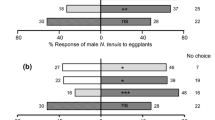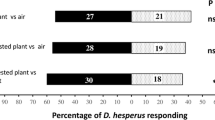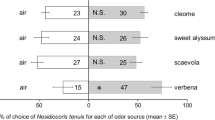Abstract
Nesidiocoris tenuis, an omnivorous arthropod, infests plants in either the absence or presence of prey arthropods. We studied whether plant-infestation experience of N. tenuis affected its subsequent prey-finding behavior. We used sesame plants and eggplants as food plants for N. tenuis, and common cutworm (CCW) (Spodoptera litura larvae) as prey. We focused on their olfactory response to CCW-infested sesame plants versus CCW-infested eggplants in a Y-tube olfactometer. When N. tenuis adults experienced the infestation of sesame plants for one day, they preferred volatiles from CCW-infested sesame plants to those from CCW-infested eggplants. By contrast, when N. tenuis experienced the infestation of eggplants for one day, they showed no difference in their preference between the two odor sources. When the duration of the infestation of plants was increased to four days, N. tenuis that had experienced sesame plants showed a reversed response: they preferred CCW-infested eggplant volatiles, while those that had infested eggplants again showed no difference in their preference. Next, we studied the olfactory preference of N. tenuis that had previously infested plants with moth (Ephestia kuehniella) eggs. We found that irrespective of plant species and of duration of experience (either one or four days), N. tenuis adults that had previously experienced one plant species showed a significant preference for volatiles from CCW-infested plants of the same species. The blends of the volatiles emitted from CCW-infested sesame plants and those from CCW-infested eggplants were qualitatively different. Possibility to control the olfactory response of N. tenuis to certain prey-infested plant volatiles by adjusting their feeding history is discussed.




Similar content being viewed by others
References
Arimura G, Matsui K, Takabayashi J (2009) Chemical and molecular ecology of herbivore-induced plant volatiles: proximate factors and their ultimate functions. Plant Cell Physiol 50:911–923
Calvo FJ, Bolckmans K, Belda JE (2009) Development of a biological control-based Integrated Pest Management method for Bemisia tabaci for protected sweet pepper crops. Entomol Exp Appl 133:9–18
De Backer L, Megido RC, Fauconnier M-L, Brostaux Y, Francis F, Verheggen F (2015) Tuta absoluta-induced plant volatiles: attractiveness towards the generalist predator Macrolophus pygmaeus. Arthropod Plant Interact 9:465–476
Fujiwara C, Takabayashi J, Yano S (2000) Oviposition experience on a host-infested plant affects flight and antennal searching behavior of Cotesia kariyai toward the host-plant complex. Entomol Exp Appl 97:251–256
Fukushima J, Kainoh Y, Honda H, Takabayashi J (2001) Learning of host-infested plant volatiles in the larval parasitoid Cotesia kariyai. Entomol Exp Appl 99:341–346
Fukushima J, Kainoh Y, Honda H, Takabayashi J (2002) Learning of herbivore-induced and nonspecific plant volatiles by a parasitoid, Cotesia kariyai. J Chem Ecol 28:579–586
Glinwood R, Ahmed E, Qvarfordt E, Ninkovic V (2011) Olfactory learning of plant genotypes by a polyphagous insect predator. Oecologia 166:637–647
Itou M, Watanabe M, Watanabe E, Miura K (2013) Gut content analysis to study predatory efficacy of Nesidiocoris tenuis (Reuter) (Hemiptera: Miridae) by molecular methods. Entomol Sci 16:145–150
James DG (2003) Synthetic herbivore-induced plant volatiles as field attractants for beneficial insects. Environ Entomol 32:977–982
Lins JCJ, van Loon JJA, Bueno VHP, Lucas-Barbosa D, Dicke M, van Lenteren JC (2014) Response of the zoophytophagous predators Macrolophus pygmaeus and Nesidiocoris tenuis to volatiles of uninfested plants and to plants infested by prey or conspecifics. BioControl 59:404–418
Lou Y-G, Cheng J-A (2003) Role of rice volatiles in the foraging behaviour of the predator Cyrtorhinus lividipennis for the rice brown planthopper Nilaparvata lugens. BioControl 48:73–86
Moayeri HRS, Ashouri A, Brodsgaard HF, Enkegaard A (2006) Odour-mediated responses of a predatory mirid bug and its prey, the two-spotted spider mite. Exp Appl Acarol 40:27–36
Moayeri HRS, Ashouri A, Brodsgaard HF, Enkegaard A (2007a) Males of the predatory mirid bug Macrolophus caliginosus exploit plant volatiles induced by conspecifics as a sexual synomone. Entomol Exp Appl 123:49–55
Moayeri HRS, Ashouri A, Poll L, Enkegaard A (2007b) Olfactory response of a predatory mirid to herbivore induced plant volatiles: multiple herbivory vs. single herbivory. J Appl Entomol 131:326–332
Mochizuki M, Yano E (2007) Olfactory response of the anthocorid predatory bug Orius sauteri to thrips-infested eggplants. Entomol Exp Appl 123:57–62
Oksanen J, Blanchet FG, Kindt R, Legendre P, Minchin PR, O’Hara RB,. Simpson GL, Solymos P, Stevens MHH, Wagner H (2016) Vegan: Community Ecology Package. R package version 2.3-5. URL https://CRAN.R-project.org/package=vegan
Peñaflor MFGV, Erb M, Miranda LA, Werneburg AG, Bento JMS (2011) Herbivore-induced plant volatiles can serve as host location cues for a generalist and a specialist egg parasitoid. J Chem Ecol 37:1304–1313
R Core Team (2016) R: A language and environment for statistical computing. R Foundation for Statistical. Computing, Vienna, Austria. URL https://www.R-project.org/
Rim H, Uefune M, Ozawa R, Takabayashi J (2015) Olfactory response of the omnivorous mirid bug Nesidiocoris tenuis to eggplants infested by prey: specificity in prey developmental stages and prey species. Biol Control 91:47–54
Sanchez JA (2008) Zoophytophagy in the plantbug Nesidiocoris tenuis. Agric For Entomol 10:75–80
Shimoda T, Takabayashi J, Ashihara W, Takafuji A (1997) Response of predatory insect Scolothrips takahashii toward herbivore-induced plant volatiles under laboratory and field conditions. J Chem Ecol 23:2033–2048
Sokal RR, Rohlf FJ (1995) Biometry: the principles and practice of statistics in biological research, 3rd edn. Freeman and Company, New York
Takabayashi J (2014) Infochemical webs and tritrophic interactions. In: eLS. John Wiley & Sons Ltd, Chichester. http://www.els.net [doi: 10.1002/9780470015902.a0021912]
Takabayashi J, Dicke M (1992) Response of predatory mites with different rearing histories to volatiles of uninfested plants. Entomol Exp Appl 64:187–193
Takemoto H, Powell W, Pickett J, Kainoh Y, Takabayashi J (2009) Learning is involved in the response of parasitic wasps Aphidius ervi (Haliday) (Hymenoptera: Braconidae) to volatiles from a broad bean plant, Vicia faba (Fabaceae), infested by aphids Acyrthosiphon pisum (Harris) (Homoptera: Aphididae). Appl Entomol Zool 44:23–28
Tamò C, Ricard I, Held M, Davison A, Turlings T (2006) A comparison of naïve and conditioned responses of three generalist endoparasitoids of lepidopteran larvae to host-induced plant odours. Anim Biol 56:205–220
Turlings TCJ, Wäckers F, Vet LEM, Lewis WJ, Tumlinson JH (1993) Learning of host-finding cues by hymenopterous parasitoids. In: Papaj DR, Lewis AC (eds) Insect learning: ecology and evolutionary perspectives. Chapman and Hall, New York
Uefune M, Kugimiya S, Ozawa R, Takabayashi J (2013) Parasitic wasp females are attracted to blends of host-induced plant volatiles: do qualitative and quantitative differences in the blend matter? [version 2; referees: 2 approved]. F1000Research 2:57. doi:10.12688/f1000research.2-57.v2
Urbaneja A, Tapia G, Fernández E, Sánchez E, Contreras J, Bielzaa P (2003) Influence of the prey on the biology of Nesidiocoris tenuis (Hem.; Miridae). IOBC/WPRS. Bulletin 26:159
Venzon M, Janssen A, Sabelis MW (1999) Attraction of a generalist predator towards herbivore-infested plants. Entomol Exp Appl 93:303–312
Wei K, Tang YL, Wang XY, Yang ZQ, Cao LM, Lu JF, Liu ES, Liu GJ (2013) Effects of learning experience on behaviour of the generalist parasitoid Sclerodermus pupariae to novel hosts. J Appl Entomol 137:469–475
Xue M, Pang Y-H, Wang H-T, Li Q-L, Liu T-X (2010) Effects of four host plants on biology and food utilization of the cutworm, Spodoptera litura. J Insect Sci 10:22
Acknowledgements
We thank Indranil B. Mukherjee for his comments on a previous version of the manuscript. This study was supported in part by Grants for Scientific Research (B) from the Ministry of Education, Culture, Sports, Science and Technology of Japan and by a Japanese Government (MEXT) scholarship for Research Students.
Author contributions
HR, MU, JT conceived and designed the experiments. HR, RO performed the experiments. HR, MU, KY analyzed the data. HR, JT wrote the manuscript.
Author information
Authors and Affiliations
Corresponding author
Additional information
Handling Editor: Patrick De Clercq.
Rights and permissions
About this article
Cite this article
Rim, H., Uefune, M., Ozawa, R. et al. Experience of plant infestation by the omnivorous arthropod Nesidiocoris tenuis affects its subsequent responses to prey-infested plant volatiles. BioControl 62, 233–242 (2017). https://doi.org/10.1007/s10526-017-9791-2
Received:
Accepted:
Published:
Issue Date:
DOI: https://doi.org/10.1007/s10526-017-9791-2




